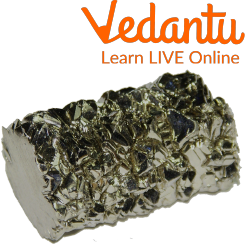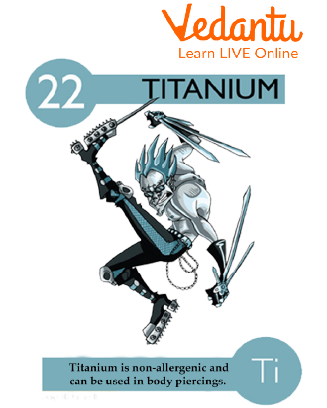




Why Is Titanium So Important in Everyday Life?
Titanium is a chemical element with the symbol Ti and atomic number 22. It is found in nature only as an oxide. To produce a lustrous transition metal, it can be reduced with a silver colour, low density, and high strength, unaffected by corrosion in sea water, aqua regia, and chlorine. Titanium is twice strong as sodium. Titanium metal is brittle when cold and can be broken easily both at room temperature and high temperatures; it becomes malleable and ductile.
In this article, we will study the titanium element and some interesting facts about it.
Titanium: The Superhero Element
For an element with superpowers, atomic number = 22, titanium encompasses a fitting origin story: It is cast in the depths of supernovas or collapsing stars. A 2012 study of a selected dying star, Supernova 1987A, found that a single supernova can produce 100 Earths worth of titanium-44, a radioactive isotope of titanium atomic no. 22, by mass.
The ninth most abundant metal in Earth's crust is Titanium, according to Chemicool, but it wasn't discovered until 1791. Rev. William Gregor, an English amateur geologist, discovered some black, metallic sand in a creek bed, analysed it and discovered it to be a mixture of magnetite, a simple form of iron oxide, and new metal. Gregor knew it as Manaccanite for the parish in which he'd discovered the sand.
After 4 years, when a German scientist named Martin Heinrich Klaproth was studying an ore from Hungary and realised that it contained a never-before-described chemical element. He named it titanium and later confirmed that Gregor's Manaccanite contained titanium.
M.A. Hunter was the first person to distil titanium into its pure form and was an employee of General Electric, according to the Royal Society of Chemistry (RSC). It wasn't till the 1930s, however, that William J. Kroll made up a method that made extracting titanium possible on an industrial scale. The alleged Kroll process initially treats titanium oxide ore with chlorine, producing titanium chloride.
Next, Mg (magnesium) or metallic elements are mixed with the atomic number 22 chloride in atomic number 18 gas (allowing chemical elements into the proceedings would be quite explosive, indeed, only if atomic number 22 is very reactive to chemical elements, in line with the RSC). Below temperatures of 2,192oF (1,200 oC), the Mg or metallic element sodium reduces the titanium chloride to pure titanium.

Titanium
Properties of Titanium
Some Interesting facts about titanium are as follows:
Atomic Number: 22
Atomic Symbol of Titanium: Ti
Atomic Mass: 47.867
Density: 4.5 grams per cubic centimetre
Phase at Room Temperature: Solid
The Melting Point of Titanium: 3,034.4 oF (1,668 oC)
Boiling Point: 5,948.6 oF (3,287 oC)
Number of Isotopes: 18; five are stable
The most common isotopes of Titanium are Titanium-46, Titanium-47, Titanium-48, Titanium-49 and Titanium-50
Uses of Titanium
Given below are the uses of Titanium.
Titanium is as well built(strong) as steel but much less dense. It is so vital as an alloying agent with several metals, including aluminium, molybdenum and iron. These alloys are primarily used in aircraft, spacecraft and missiles because of their low density and ability to withstand temperature extremes. They are additionally used in golf clubs, laptops, bicycles and crutches.
Power plant condensers use metallic element pipes due to their corrosion resistance. As a result, the metallic element has wonderful resistance to corrosion in seawater, it's employed in chemical process plants and to shield the hulls of ships, submarines and alternative structures exposed to seawater.
Titanium metal connects well with bone; therefore, it is found in surgical applications such as joint replacements (especially hip joints) and tooth implants.
The largest use of titanium is within the kind of titanium(IV) oxide. Titanium(IV) is extensively used as a pigment in house paint, artists’ paint, plastics, enamels and paper. It is a bright white pigment with excellent covering power. It's a bright white pigment with wonderful covering power. It is additionally a decent reflector of infrared emission and then is employed in star observatories wherever heat causes poor visibility.
Fun Facts about Titanium
Given below are some cool facts about titanium.
According to the RSC, nearly all igneous rock — rocks which are formed from the solidification of molten rock — contains titanium.
Titanium is orbiting the planet right now: The International Space Station (ISS) incorporates a range of titanium parts and pipes in line with NASA. A research and archiving venture to preserve human languages and thought has also flown an etched piece of pure titanium outside the ISS in the Rosetta Project to see how it stands up to radiation and the harsh environment of space.
Earth isn't the only place to find titanium. In 2011, a satellite map of the moon's surface disclosed clusters of titanium-rich rock. These rocks frequently contained up to 10 per cent titanium, compared to the 1 per cent or so typically seen in Earth rocks.
Titanium is used as the stuff in 3D printing. In 2013, researchers at Australia's Commonwealth Scientific and Industrial Analysis Organization 3D-printed lightweight titanium horseshoes for racehorses. The shoes were in trendy hot-pink colour.

Fact About Titanium
Summary
In this article, we learned about titanium, a chemical element with the symbol Ti and atomic number 22. It is found in nature only as an oxide. To produce a lustrous transition metal, it can be reduced with a silver colour, low density, and high strength, unaffected by corrosion in sea water, aqua regia, and chlorine. We have also learned some interesting facts about Titanium and how it is a superhero element.
And some fun facts about the element it uses; we have also learnt that titanium is so vital as an alloying agent with several metals, including aluminium, molybdenum and iron. We hope you enjoyed reading this article.
FAQs on Interesting Facts About Titanium: Properties, Uses & More
1. What is so special about the metal titanium?
Titanium is special due to its unique combination of properties. It has the highest strength-to-density ratio of any metallic element, meaning it is as strong as many types of steel but significantly lighter. It is also highly corrosion-resistant and biocompatible, making it non-toxic to the human body.
2. What are some common uses of titanium?
Due to its strength, low weight, and corrosion resistance, titanium is used in many high-performance applications. Some common examples include:
Aerospace: Aircraft frames, engines, and spacecraft components.
Medical: Surgical implants like hip and knee replacements, dental implants, and pacemakers.
Consumer Goods: High-end bicycle frames, golf clubs, laptops, and watch casings.
Industrial: Power plant condensers and desalination plants where resistance to seawater corrosion is vital.
3. How does titanium's strength compare to that of steel?
Titanium is comparable in strength to many common high-strength steel alloys. However, its primary advantage is its density. Titanium is approximately 45% lighter than steel for the same volume. This excellent strength-to-weight ratio is why it is preferred in applications where both strength and low weight are critical, such as in the aerospace industry.
4. How does titanium resist corrosion so effectively?
Titanium's remarkable resistance to corrosion is not inherent to the metal itself but is due to a protective layer that forms on its surface. When exposed to oxygen in the air or water, it instantly forms a thin, stable, and highly durable layer of titanium dioxide (TiO₂). This passive oxide film is self-healing and protects the underlying metal from rust and other forms of corrosion, even in harsh environments like saltwater.
5. Where is titanium found on Earth?
Titanium is not found as a pure metal in nature. It is the ninth most abundant element in the Earth's crust. It is typically extracted from minerals, primarily ilmenite (FeTiO₃) and rutile (TiO₂). Major producers of these minerals include Australia, South Africa, China, and Canada.
6. Is titanium brittle or easily broken?
Pure titanium can be brittle at room temperature and may fracture under sharp impact. However, when alloyed with other elements such as aluminium or vanadium, its properties change dramatically. Titanium alloys are renowned for their excellent toughness and high tensile strength, making them very resistant to breaking under stress while remaining ductile.
7. Does titanium have a high melting point?
Yes, titanium has a very high melting point, which is one of its key characteristics. It melts at approximately 1,668°C (3,034°F). This is significantly higher than that of aluminium (660°C) and much higher than most steel alloys, making it suitable for use in high-temperature environments like jet engines.









